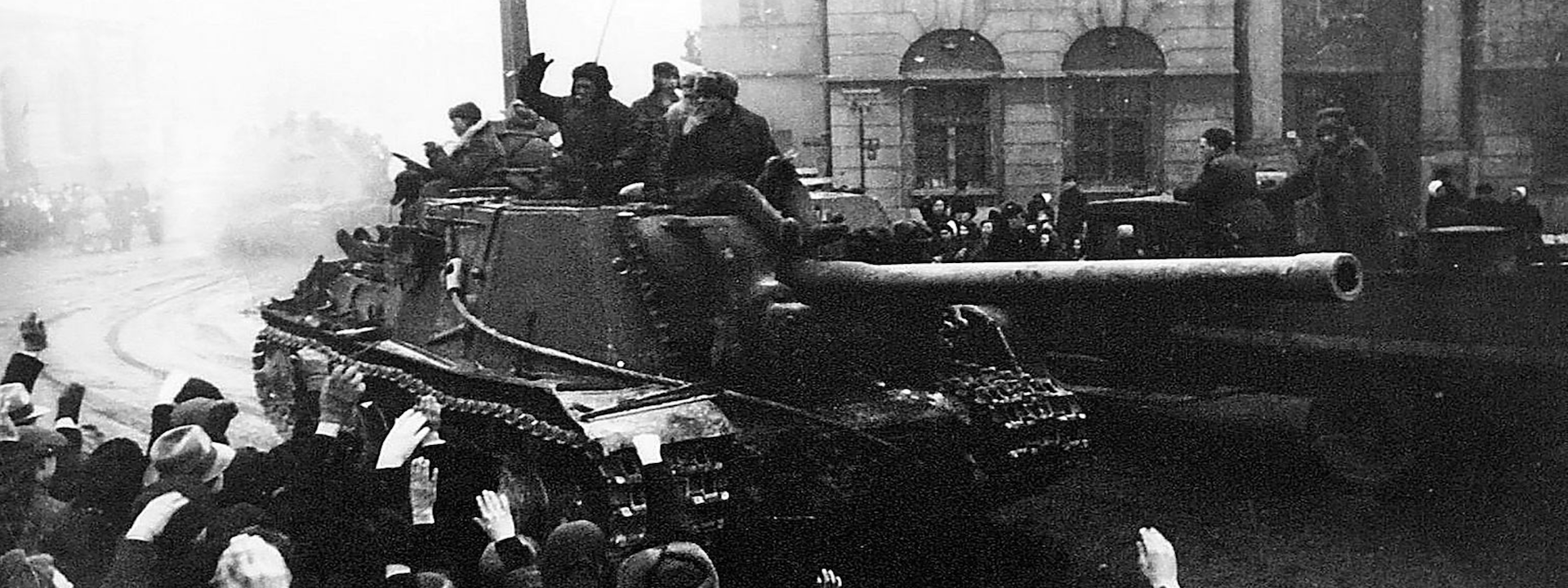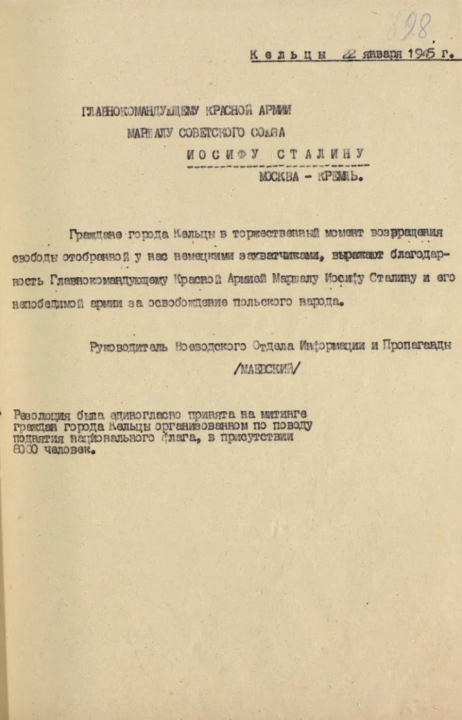History Revisited: Communist Monuments in Poland
How the Kremlin is re-writing Poland’s history to protect Communist monuments
History Revisited: Communist Monuments in Poland

BANNER: Source: dzienniklodzki.pl
Poland recently passed a law banning propaganda from the Communist era. An ensuing row on social media included a coordinated narrative from Russia insinuating anyone not grateful for the Red Army’s liberation of Poland during WWII does not appreciate history (at best) or inherently supports the Nazi cause (at worst).
Attempts at re-writing the history of its neighbors by Russia are well-documented. Recently, @DFRLab demonstrated how the Russian Ministry of Foreign Affairs attacked the Baltic States and NATO on social media over a video shared by NATO’s social media channels. The video was about the Forest Brothers, irregular armed units in the Baltic states who fought against Soviet forces after the end of World War II, from 1945 to 1953. As the row over the Forest Brothers video is cooling off, the Russian Ministry of Foreign Affairs is picking another fight over history, this time with Poland.
Opposing Polish and Russian groups are employing hashtags, websites, and perhaps even botnets to color the Red Army’s effects on Poland as either good or bad. The incident ultimately shows the Kremlin’s willingness to distort facts in order to maintain influence over its neighbors.
Polish propaganda law
On July 18, Polish President Andrzej Duda signed into a law amendments banning Communist propaganda. These amendments include an order to dismantle monuments and to rename objects related to the country’s Communist past. The law excludes “objects with educational or cultural significance” and is part of the government’s broader effort to disavow the remnants of the Soviet occupation of Poland that lasted from 1939 to 1989.
Soon after the law was passed, Russia’s government responded with threats of “sanctions against individual Polish politicians behind the new law,” “restrictions on Polish-Russian economic contacts,” and “active work at a variety of international venues to draw attention to the issue.” A journalist at the Kremlin media outlet RT even cited unnamed journalists who suggested that “if Poland will refuse its communist past[,] it also must refuse its western borders, which were given to it by Stalin.”
For Russia, the Soviet Union’s invasion of Poland in 1939 and the ensuing war against Nazi Germany, which led to the Soviet Union’s victory and full occupation of Poland in 1945, was a liberation of Poland from Nazi Germany. For Poland, the Soviet Union’s victory eventually led to a 50-year-long occupation under the Iron Curtain, and this is what its remaining Communist monuments represent.
New media meets old history
The row over history manifested on Twitter.
The Twitter account of the Russian Embassy in Canada shared an image showing “grateful Polish citizens thanking and praising the Red Army”:
Over 600 000 Red Army soldiers and officers died liberating Poland. Photo of grateful Polish citizens thanking and praising the Red Army. pic.twitter.com/fi05MMhCx5
— Russia in Canada (@RussianEmbassyC) July 18, 2017
Shortly after the first tweet, the same embassy attempted to launch the hashtag campaign #RedArmyLiberatedPoland, which was widely unsuccessful.
Polish law to demolish monuments to Red Army heroes a grave insult to memory of our fallen #RedArmyLiberatedPoland https://t.co/aVyEhsjgkV pic.twitter.com/nS7ObOZ4qr
— Russia in Canada (@RussianEmbassyC) July 18, 2017
The hashtag was used only in two other tweets, one calling out the historical inaccuracy peddled by Russia’s diplomatic corps, and another sharing pictures of the Katyn Massacre in 1940, when the Soviet secret police massacred over 20,000 Poles.
It appears that the Russian Embassy in Canada was attempting to replicate the success of the Lithuanian social media campaign #Kremlinyouwillnotfalsifyourhistory. This hashtag was launched by Andrius Tapinas in response to Russia’s historically inaccurate comments about the Forest Brothers. Thirty thousand people used the hashtag #Kremlinyouwillnotfalsifyourhistory.
The Russian Embassy in the United States also tweeted about the issue, but without using the hashtag:
All #NaziCamp's in Poland were freed by Soviet soldiers
Poland now removes monuments of gratitude to #RedArmy➡️https://t.co/MNw7EJRrR7 #WWII https://t.co/tCa2jqZ8gz— Russian Embassy in USA 🇷🇺 (@RusEmbUSA) July 21, 2017
Alexey Pushkov, a senator from Perm Krai and a former member of the Duma, also tweeted without using the hashtag:
Изображая жертву, Польша готова рушить "советские памятники". Но в ее прошлом много преступлений. Она не жертва. Об этом 21.00, Постскриптум
— Алексей Пушков (@Alexey_Pushkov) July 22, 2017
Some bot activity was detected in the spread of Russian- and English-language articles on the topic. An RT article titled “Upper House asks Putin to slap sanctions on Poland over anti-monument bill” was retweeted by 29 Twitter accounts, 24 of which appear to be bots.
The social media assault on Poland’s history was accompanied by a website that the Russian Ministry of Defense launched at the end of July.
The website, titled “The Liberation of Poland: The price of victory” hosts some recently declassified historical documents that allegedly prove that Poles welcomed their Soviet liberators in 1944 and promised to “immortalize the Red Army soldiers in monuments.”
A Russian Ministry of Defense statement that accompanied the launch of the website reads:
Among the declassified documents — combat reports and memoranda, reports and references, historical forms and telegrams — is impartial evidence of the bloody battles the Red Army fought for the liberation of its brother republic [Poland].
The documents released by the Russian Ministry of Defense, appear to be one-sided. For example, they feature a telegram from the head of the Provincial Department of Information and Propaganda to Joseph Stalin that reads:

The translation of the telegram pictured above reads: “The citizens of the town of Kielce […] thank Commander-in-Chief of the Red Army Joseph Stalin and his unconquered army for the liberation of the Polish people.”
Moreover, the de-classified documents do not mention that the enthusiasm toward the Red Army quickly faded in the aftermath of the World War II, as the Soviet Union commenced deportations, collectivization, and massacres of prisoners of war and dissidents carried out by secret police.
The website appears to have been launched to coincide with the adoption of the new law. An RT article about the launch of the website states:
The declassification comes after Poland introduced a law in late June that bans any propaganda of totalitarian regimes, such as the Soviet one, including any mention of the names on buildings or other architectural sites. There are fears this could result in the destruction of memorials to Red Army soldiers who died liberating Poland from the Nazis.
The current state-of-play resembles that of 2007 when Estonian authorities relocated the Soviet-era Bronze Soldier war memorial to a cemetery, leading ethnic Russians to riot in Tallinn in protest.
Conclusion
This row shows that Russia still sees its western neighbors as part of its sphere of influence where it can mobilize an effort to impact domestic policies. Here again, Russia presents selective or one-sided or distorted historical information to its current political advantage. As the dispute over the Forest Brothers also indicated, some battle lines of the past survive as political fault lines today, and coordinated narrative campaigns have become a primary weapon.

